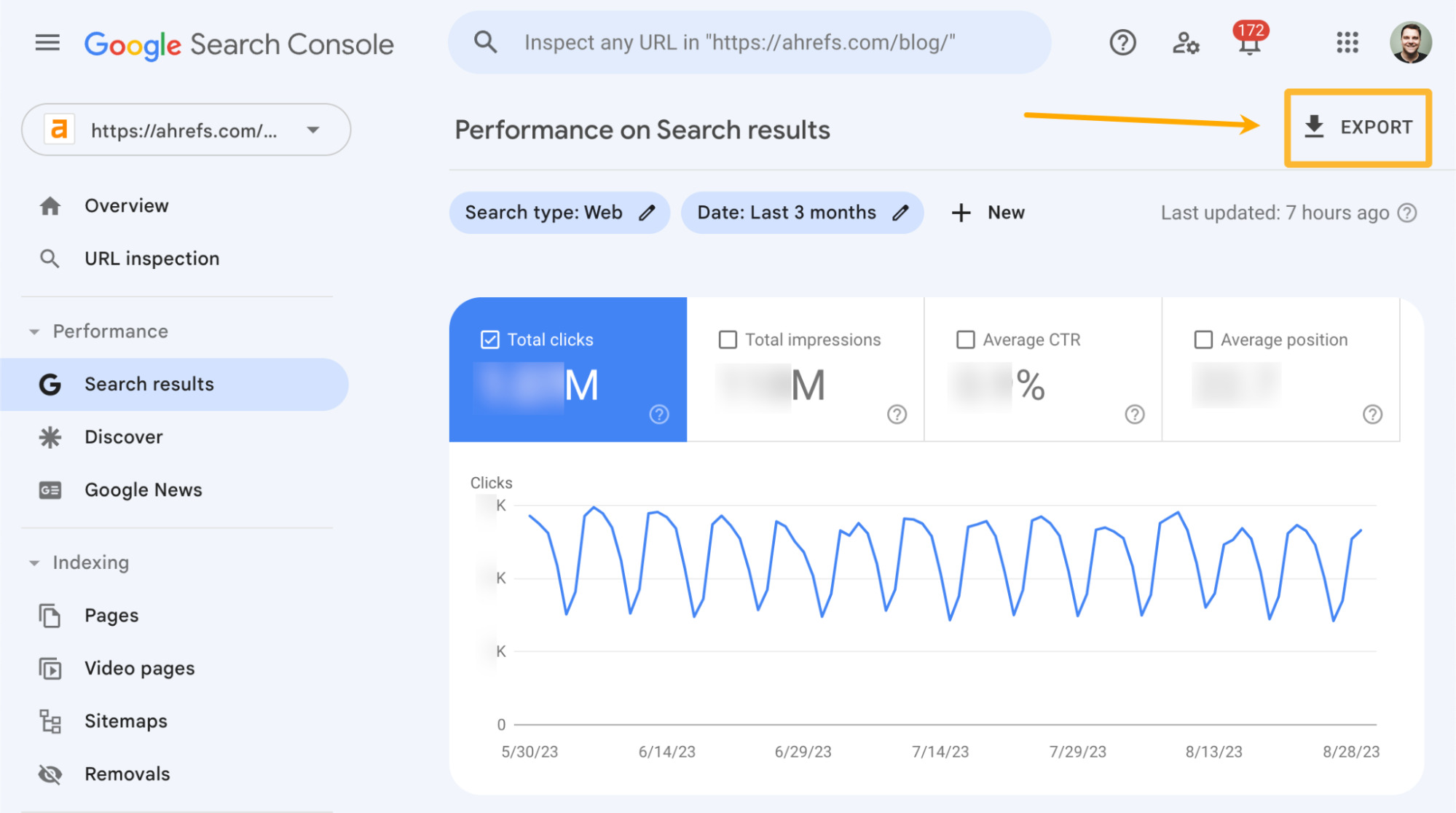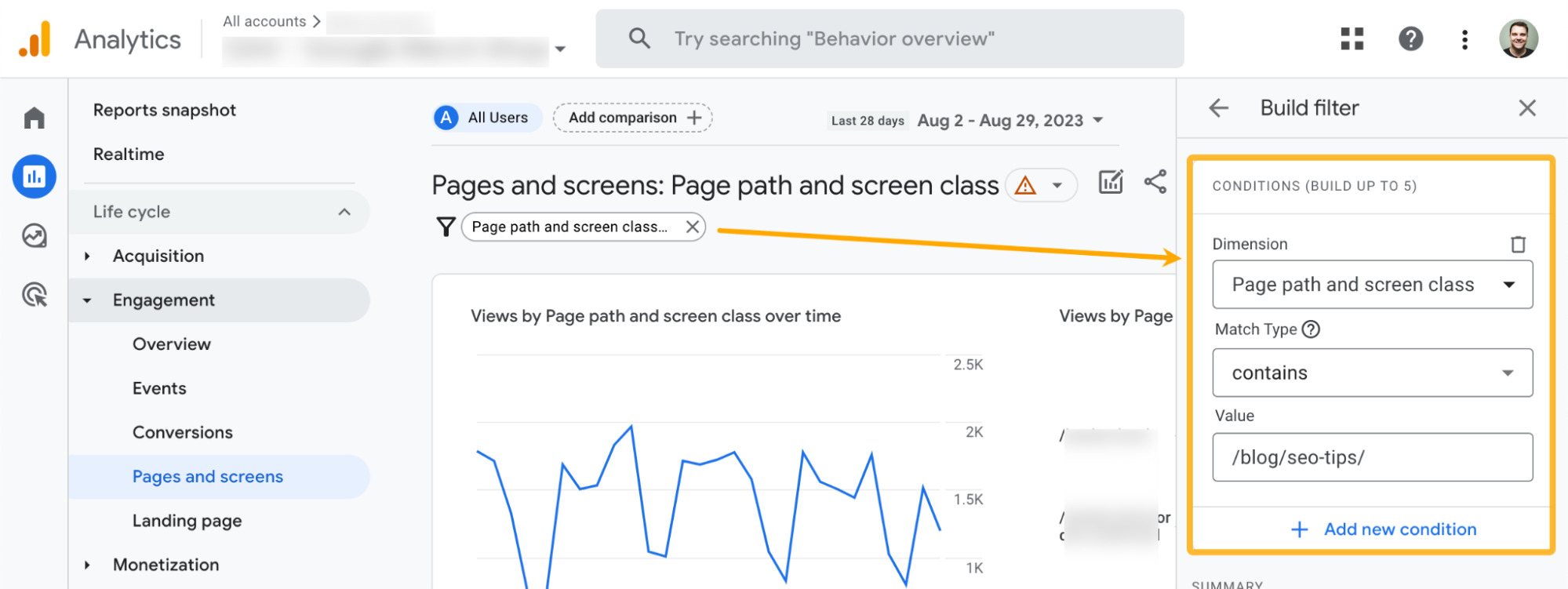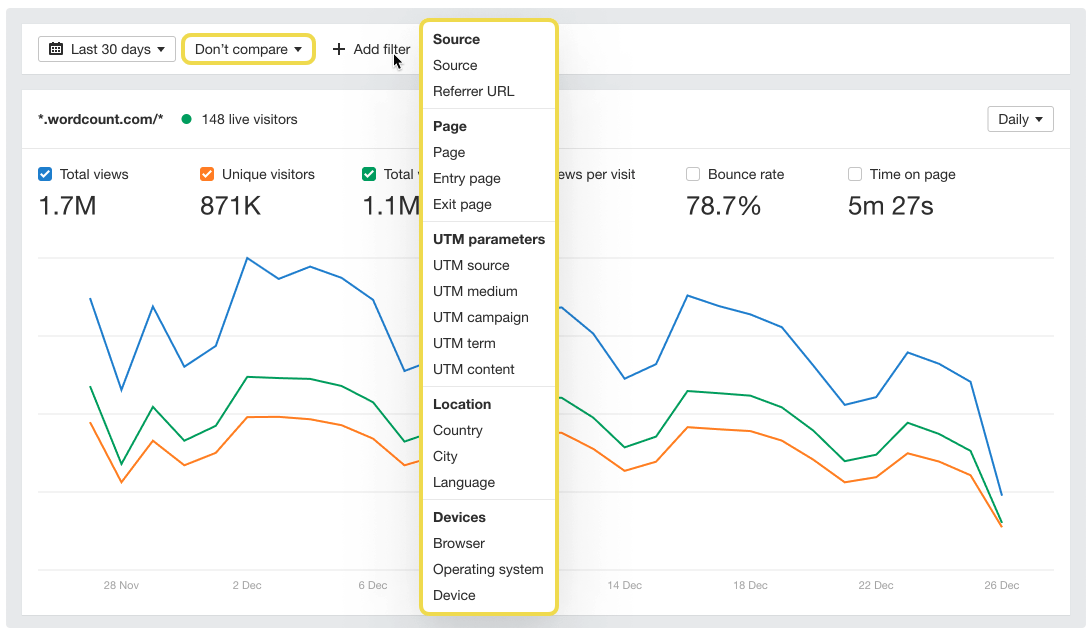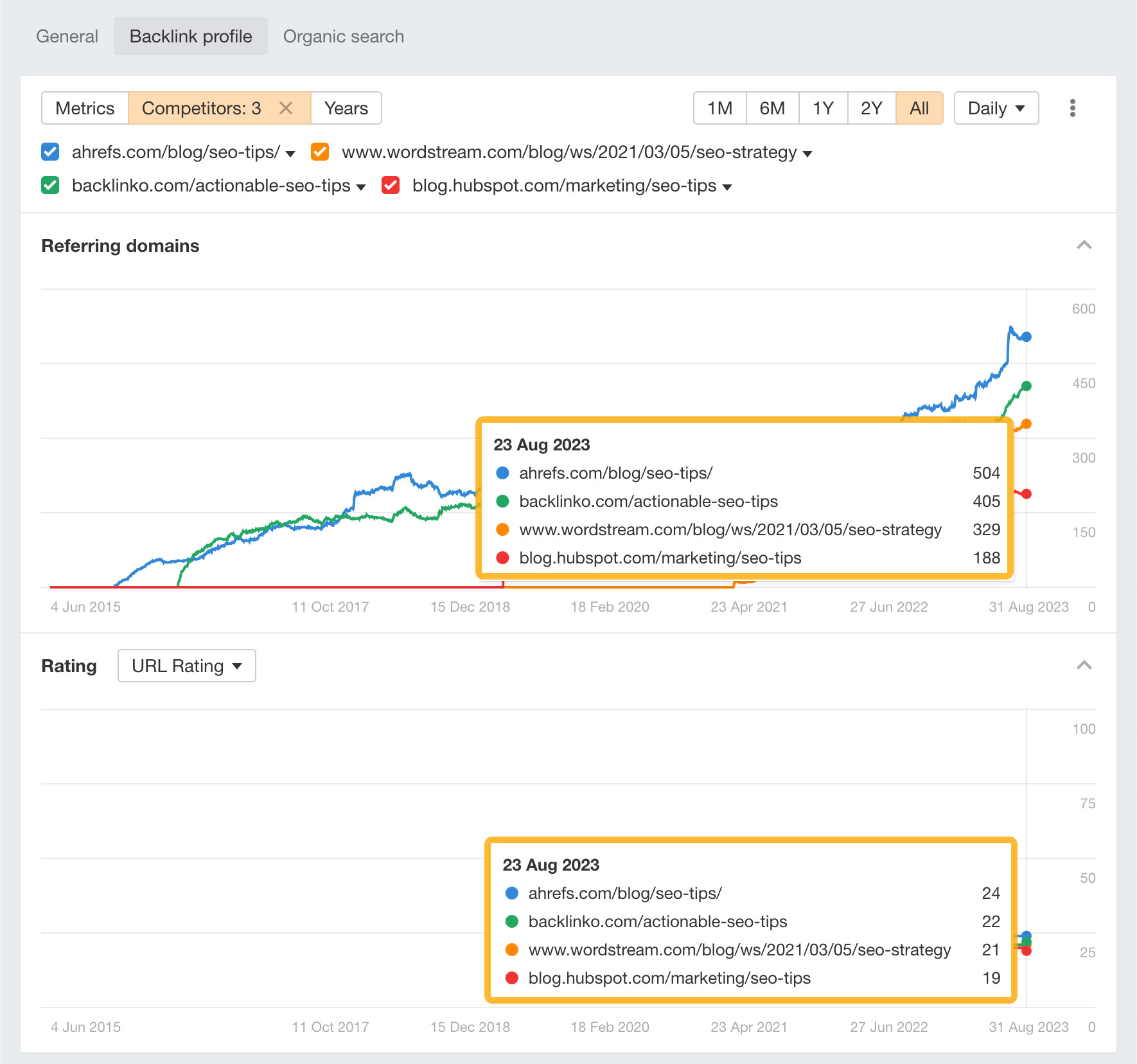Even if you pour your heart and soul into your content, it’ll often fail to rank, convert, or do anything for your business. It’s frustrating.
But you don’t have to leave these pages to die a slow, painful death. You can revisit them, figure out what went wrong, and take action to improve their performance. This is the content audit process in a nutshell—and it’s a key part of a successful content strategy.
Let’s go through how to do one using our content audit template and interactive process.
Our SEO WordPress plugin automates and handles many of the steps in the content audit process below.
Every content audit process is roughly the same. You ask questions to figure out what, if anything, is holding your content back, then make improvements in those areas.
To do this, you need three things:
- A list of website pages/URLs to audit
- A robust* content audit checklist
- The right content audit tools
You can collect URLs freely and easily with an Ahrefs Webmaster Tools (AWT) account. Just crawl your website with Site Audit, go to the “Bulk export” tab, and export “Internal HTML URLs, status code 200.”

You can then just copy and paste the URLs (“URL” column) into our content audit template:

That said, if you have thousands of pages, it can be quite time consuming to run them all through a content audit. I recommend following the 80/20 rule and auditing the top 20% of pages with the most organic traffic or backlinks. You’ll probably get 80% of results from doing this.
You’ll find columns for backlinks and estimated organic traffic in the Site Audit export too. Just copy and paste them over into the content audit template, then filter for pages that meet your minimum organic traffic and backlink requirements.

Export the data from Google Search Console (Performance > Search results) and merge into the content audit template.

Next, it’s just a case of auditing your pages with our interactive content audit process.
Here’s how to use it:
1. Open the process in the presenter view. (You can close the dedicated presenter view window.)

2. Go through the process for each page by answering the yes/no questions. It will tell you what action(s) to take based on your answers. (If you’re not sure how to answer, click the “How to check?” link for instructions.)

3. Log the recommended actions for each page by ticking the checkboxes in your content audit spreadsheet. For example, if it recommends adding internal links and building more backlinks, tick those boxes.

Once you’re done, implement the changes yourself or pass the completed content audit to another member of your team or a freelancer. Each of the action items links to an SOP or guide to make life easy.

Below are the questions our content audit process will walk you through.
If you use WordPress, our SEO plugin automates many (but not all) of the steps below. Otherwise, you’ll need to pull all the data into a spreadsheet and create some logic for the recommendations using the content audit workflow.
If you’re wondering why we didn’t create this content audit template ourselves, it’s because it’s virtually impossible to make it work for everyone, as everyone has a slightly different setup.
Also, pulling data from multiple sources gets real messy real quick, and minor changes to exports or formatting often cause things to break.
Does the page get organic traffic?
Go to the Search results report in Google Search Console and filter for the page. You’ll see how many clicks it got from organic search over the last three months.

If you don’t have Search Console set up (hint: you should, it’s free), you can plug the page into Ahrefs’ Site Explorer or our free traffic checker for a rough estimate.

Does the page get traffic from another source?
This is something that only your analytics can answer.
If you’re using Google Analytics, in your Google Analytics account, go to Reports > Lifecycle > Engagement > Pages and screens. From here, you can filter for a particular page by adding a “Page path and screen class” filter and pasting in the URL slug.

This will tell you whether the page gets traffic from organic or other sources.

Is the page mainly for organic search?
Pretty straightforward. If the main purpose of the page is to rank in search engines, the answer to this question is “yes.” If that’s not why you created the page, the answer is “no.”
Is the page useful for another purpose?
Not all pages need traffic to justify their existence. Here are a few examples of website pages you probably need to keep around regardless of whether they attract traffic:
- Terms of service (ToS) pages
- Privacy policy
- Disclaimer
- Category or tags pages
- Squeeze/landing pages for paid ads
- Anything that assists with conversions or navigation in other ways (social proof, user stories, etc)
This is not an exhaustive list, but you get the idea.
Does the page have any backlinks?
Plug the URL into Ahrefs’ Site Explorer and check how many referring domains (linking websites) it has:

If this number is above zero, the page has backlinks.
Is the page crawlable and indexable?
Google can’t index pages that aren’t indexable, and pages that aren’t crawlable are rarely indexed. The easiest way to spot-check both of these things is with the URL Inspection Tool in Google Search Console.
Here’s what you want to see under the “Page indexing” tab:
- Crawl allowed? Yes
- Indexing allowed? Yes
- User-declared canonical: [same as the page’s URL or empty]

If this is what you see and the page isn’t redirected (Google tells you if this is the case too, see above), then it’s indexable and crawlable.
Has the page had time to be successful?
Pages rarely rank overnight. It takes time. If it’s been less than six months since you published or significantly updated a page, it’s possible that it just needs a bit more time to experience success in organic search.
Is ranking the page a priority?
Nobody has infinite resources, so there’s no point in breaking your back trying to rank pages that don’t matter much. You need to prioritize.
There’s no exact formula for what should and shouldn’t be a priority. It depends on your business. We typically judge pages by their business potential and search traffic potential.
Business potential scores how easy it will be to pitch your product or service on a page.
Here’s the scale we use:

Traffic Potential is how much organic search traffic the page could get if it ranks #1. You’ll find this metric (and many other SEO metrics) in Ahrefs’ Keywords Explorer. We calculate it by estimating the total amount of organic search traffic to the current top-ranking page.

Could the page get more organic traffic?
Plug the main focus keyword your page targets into Ahrefs’ Keywords Explorer and check the Traffic Potential (TP) metric. This is the top-ranking page’s estimated organic search traffic from all the keywords it ranks for, which is usually a good proxy for the TP of the topic.

If this number is higher than the estimated search traffic to your page (in the chosen country), then it can probably get more traffic. You can check this by plugging your page’s URL into Ahrefs’ Site Explorer.

For some keywords, the top-ranking page isn’t the best one to derive traffic potential from.
For example, the Traffic Potential for “google search console” is 33K. But if you look at which page the estimate is derived from, it’s Google’s official page about Search Console.

Given that you’re unlikely to ever outrank this, it’s better to look for a page similar to yours in the search engines results and derive traffic potential from that. In this case, the top four results are all official pages from Google, so this guide in position #9 is probably a truer estimate of the topic’s Traffic Potential.

Is another page on your site ranking for the same targeted term(s)?
Plug your site into Ahrefs’ Site Explorer, go to the Organic keywords report, then filter for “Multiple URLs only” and the keyword you’re targeting. If the keyword shows up in the report, multiple pages are ranking for it.

Is the page unique enough to also target other terms?
Having multiple pages ranking for the same keyword isn’t always a bad thing. If each page is vastly different and ranks for its own subtopics, then it can usually co-exist with the others quite happily.
To get a rough sense of how different the pages are, look at their titles. You can see these by clicking the “SERP” dropdown and toggling on “Target only.”

In this case, you can see that both ranking pages look quite similar. They’re definitions of our URL Rating (UR) metric. Based on this, the answer to “is it unique enough to target other terms?” is probably “no.”
However, in the case of “short tail keywords,” the pages that rank are quite different from each other. One is a definition page, while the other is a comparison of long- and short-tail keywords.

Based on this, the answer to “is it unique enough to target other terms?” is probably “yes.”
Is your page better than the competition?
OK. We’re definitely getting to the difficult questions now because there’s obviously some level of subjectivity here. There are a million and one things that could make your website content “better,” but a good starting point is to ask yourself these two questions:
- Does it cover the topic well?
- Is there anything unique about it?
To answer the first question, you can use Ahrefs’ Competitive Analysis tool. Just plug in your page along with two to three top-ranking pages that target the same search intent and hit “Compare.”

From here, head to the Content Gap report and look for subtopics you haven’t covered among the keywords.
For example, the keyword “affiliate marketing examples” stood out to me when doing this for our affiliate marketing guide, as I know we didn’t include examples in our blog post. So it’s clear that we could be covering the topic better.

As for the issue of uniqueness, I don’t see much to separate our post from the crowd after a quick skim. There’s very little in the way of unique data or viewpoints, so there’s definitely room for improvement on that front.
Is your page optimized well for on-page SEO?
This is about checking for basic on-page optimizations like a compelling title tag and meta description, SEO-friendly URL, optimized images, schema markup, etc. To make life easier, use the checklist in our guide to on-page SEO.
Is the page internally linked where relevant?
Internal links are links from one page on your website to another. They help pages rank by sending PageRank to them, so it makes sense to make sure that your pages have all the relevant internal links they can get.
If your page already gets a decent amount of organic search traffic, you can use the Internal link opportunities tool in Site Audit to check for missed opportunities. Just set the “Target page” filter to your page’s URL to search for mentions of keywords it ranks for across your site.
For example, if we do this for our list of content marketing examples, the tool suggests internally linking from a mention of “inspirational content” in our list of content marketing goals:

If your page doesn’t get much traffic, use the Page Explorer to run a manual search for relevant keyword mentions. Here’s how:
- Go to Page Explorer
- Click the “Advanced” filter
- Add a filter for where “Page text” > “Contains” > [relevant keyword]
- Add a filter for where “Internal outlinks” > “Not contains” > [url of the page you’re auditing]

If either of these reports show results, there are probably places where you can add relevant internal links. So the answer to this question is “no.”
Is the page’s link profile stronger than the competition?
Backlinks are one of Google’s top ranking factors, so having a weaker backlink profile than your competitors could be holding back your keyword rankings.
To check the relative strength of your profiles, enter your page’s URL into Ahrefs’ Site Explorer, click the “Backlink profile” tab, then click on the option to add competitors and enter a few top-ranking pages.
You can then compare each page’s referring domains (linking websites) and URL Rating (UR):

In this case, it looks like our link profile isn’t holding us back. Our page has more referring domains and a higher UR score than our competitors.
Are there any old deleted pages that could be redirected?
If you have any old deleted pages with backlinks about a similar topic, it’s worth redirecting them because they may help to boost your page.
Here’s how to find pages to redirect:
- Enter your domain into Ahrefs’ Site Explorer
- Go to the Best by links report
- Filter for pages with the “404 not found” HTTP code
- Filter for pages with at least one referring domain

For example, if we were auditing our blog post about Domain Rating (DR), it would make sense to redirect this old deleted page about domain authority:

Is it the strongest page ever? No. It only has four referring domains. But every little helps, and it’s an easy win.
Do you think the page could get more conversions?
If your page has maxed out its traffic potential, think about whether there’s anything you can do to make it more valuable for your business. Could it get more conversions, assisted conversions, or somehow play a better role in the user journey?
This is not my area of expertise, so I’m sure there are many ways to improve things on this front. But I’d start by asking yourself these two questions:
- Could I add any relevant calls to action (CTAs)?
- Could I better sell the product or service in the content?
For example, I recently rewrote my guide to getting indexed in Google (original was written in 2019). The main reason for this is because our product has come a long way since then, and there are more ways it can help solve the problem at hand.
We also added CTAs to some of our free tools at some point, like this one on our free backlink checker:

Just in case you missed it above, here are the templates you need:
What is a content audit?
A content audit is where you analyze the performance of your website content to find opportunities for improvement. Many content audits focus on SEO performance, but a full audit also takes into account the content’s business performance and utility.
Why is a content audit important?
A content audit is important for understanding what you need to do to improve your site’s content marketing performance. It helps you to identify pages that aren’t performing well, why they aren’t, and how to fix that. It’s a key part of any content marketing strategy.
Is a content audit just for blog posts?
No. You can audit landing pages and other types of web pages too. Just remember that some landing pages are needed regardless of how they perform (e.g., “about” page).
Final thoughts
Content audits should be done regularly. They reveal how to improve your website’s performance (SEO and otherwise) and help you achieve your business objectives.
Just remember never to delete or redirect website content unless you’re confident that it’s the best course of action. The most successful content audits need balance. If you’re unsure, hire an SEO or content marketing professional to do the content audit for you.
Got questions? Ping me on X (Twitter).



